UK  Deutsch
Deutsch 
Alternative Root Crops
Although this section is titled Alternative Root Crops, it is not restricted to the botanist's definition of a root, but also discusses all types of underground storage organs including tubers, bulbs and corms.
The traditional root crops grown in temperate regions are potatoes, parsnips, carrots, beetroot, onions, turnips and swede with lesser-known plants such as Jerusalem artichokes, celeriac, Chinese artichokes, radishes and winter radishes (mooli) playing a minor role. Of these, potatoes are by far the most important. They are very high yielding and, because they have a mild flavour that goes well with many other foods, they are widely used as a staple crop. They do have many disadvantages though, especially in their high susceptibility to disease and in particular to blight, for which there is no acceptable organic treatment as yet.
Most of these traditional crops have been selectively bred, sometimes over thousands of years, for improved flavour and yields. Potatoes, for example, were extremely low yielding when first introduced from South America. The wild carrot has a thin woody root that bears little comparison to the cultivated plant. This selective breeding, however, has not been an unconditional success. Potatoes must be one of our most disease-prone crops - sometimes it seems you only have to look at them and they go down with blight. Carrots suffer from root fly and violet root rot, assuming you can get them past the seedling stage without them being eaten by slugs or overtaken by weeds.
Many of the plants mentioned in this section, on the other hand, have never been bred as a food crop so yields will often be rather lower. They are, however, usually much less prone to pests and diseases and so are often easier to grow. They are also in general much more robust plants and can often be grown in a semi-wild setting and just harvested as required. There is an added bonus to this, since with many of the plants, such as the Erythronium species, it is possible to grow them amongst other plants and so their yield is an extra bonus from the land.
The plants detailed in the list below are rather a diverse bunch and as a result they have a variety of cultivation needs. Unless the text says otherwise you can assume that the plant will succeed in full sun or light shade in most well- drained soils, and will yield much better if the soil is fairly rich in organic matter.
.jpg) Apios americana. The GROUND NUT is an herbaceous climbing plant, reaching about 4ft tall. It belongs to the pea and bean family and, like many other members of that family, it helps to enrich the soil with nitrogen by means of bacteria that live on the roots and fix atmospheric nitrogen. The root, which is unusually high in protein, has a very pleasant sweet taste when baked. It can be cooked in many other ways and can also be eaten raw, though it is rather tough to chew. (One correspondent on the PFAF site says that this plant has some “anti nutritional factors, such as trypsin inhibitors ... so it should be cooked before being eaten”)
Apios americana. The GROUND NUT is an herbaceous climbing plant, reaching about 4ft tall. It belongs to the pea and bean family and, like many other members of that family, it helps to enrich the soil with nitrogen by means of bacteria that live on the roots and fix atmospheric nitrogen. The root, which is unusually high in protein, has a very pleasant sweet taste when baked. It can be cooked in many other ways and can also be eaten raw, though it is rather tough to chew. (One correspondent on the PFAF site says that this plant has some “anti nutritional factors, such as trypsin inhibitors ... so it should be cooked before being eaten”)
Yields from the wild plant are fairly low, though they are much better if the plant is left in the ground for 2 years before harvesting. There are a number of cultivated forms being developed, however, that have much higher yields and the plant has been recommended for commercial cultivation. This species can be grown along the sunny edges of a woodland garden and either allowed to twine its way into small shrubs or given some supports to climb into.
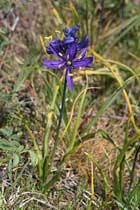
.jpg) Camassia quamash. QUAMASH is a beautiful bulbous plant that grows about 2ft tall and flowers in early summer. It belongs to the onion family (though it does not taste like it) and the flowers look a little bit like a bluebell. Plants can succeed in short grass, so long as this is not too vigorous, and can therefore be grown in the light shade of a tree in the lawn. Do not cut the grass during the time when the bulbs come into growth until they die down in mid summer. Quamash bulbs are about the size of a small onion; they are rich in starch and develop a very nice sweet flavour when slowly baked. They can also be eaten raw but their texture is somewhat 'gummy'.
Camassia quamash. QUAMASH is a beautiful bulbous plant that grows about 2ft tall and flowers in early summer. It belongs to the onion family (though it does not taste like it) and the flowers look a little bit like a bluebell. Plants can succeed in short grass, so long as this is not too vigorous, and can therefore be grown in the light shade of a tree in the lawn. Do not cut the grass during the time when the bulbs come into growth until they die down in mid summer. Quamash bulbs are about the size of a small onion; they are rich in starch and develop a very nice sweet flavour when slowly baked. They can also be eaten raw but their texture is somewhat 'gummy'.
Quamash was a staple food of the N. American Indians. Local tribes would move to the quamash fields in the early autumn and, whilst some people harvested the bulbs, others would dig a pit, line it with boulders then fill it with wood and set fire to it. The fire would heat the boulders and the harvested bulbs would then be placed in the pit and the whole thing covered with earth and the bulbs left to cook slowly for 2 days. The pit would then be opened and the Indians would feast on the bulbs until they could eat no more. Whatever was left would be dried and stored for winter use. It is possible to grow quamash in an orchard - the plants will die down before the first apples are harvested and so will not get in the way. The bulbs should increase of their own accord and then can be harvested in much the same way as the Indians, though you might not choose to eat them in quite the same way!
 Cyperus esculentus. TIGER NUTS are a noxious weed in the tropics, but are also a cultivated crop and can sometimes be found on sale in temperate regions. Plants grow about 2ft tall and prefer a sunny position in a soil that is on the wet side.
Cyperus esculentus. TIGER NUTS are a noxious weed in the tropics, but are also a cultivated crop and can sometimes be found on sale in temperate regions. Plants grow about 2ft tall and prefer a sunny position in a soil that is on the wet side.
Tiger nuts grown by Ken Fern in Cornwall seemed to be quite hardy (forms of the plant have become naturalised as far north as Alaska) but yields were disappointing. This was atleast partly because of problems getting the tubers to come into new growth in the spring. They are normally harvested after the first frosts have cut back top growth and then stored in moist sand in a cool frost-free place. In early spring they can be potted and put into a polytunnel, but they can take months before coming into growth and consequently do not manage to get in a full growing season in Britain. (Perhaps this will change with global warming.) The tubers are small and rather fiddly but they have a delicious sweet flavour. They can be eaten raw but are very chewy unless soaked beforehand. Tiger nuts are unusual amongst roots in that they contain a relatively high level of oil and this is sometimes extracted and used as a high-grade food oil.
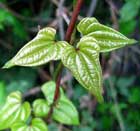
 Dioscorea batatas. This hardy YAM is cultivated in Japan as a root crop but, although it grows very well in temperate regions, it has never been grown much in Britain. A climbing plant reaching 8ft or more in height, it requires a sunny position in a fertile well-drained soil and should be given some support on which to twine. If you have a deep rich soil then the root can be up to 3ft long and weigh 4lbs or more. Rich in starch, it is best baked but can also be boiled, added to stews etc. There is no strong flavour, but the overall taste is very acceptable and it can be eaten in quantity as a staple crop. It is similar to a floury potato. You can propagate the plant by cutting off the top few inches of root and replanting this. An easier method is to harvest the small tubercles (baby tubers that look a little like small bulbs) that are formed in the leaf axils along the stems. Collect them in late summer, once they are easily detached from the plant, and pot them up immediately in a cold greenhouse. They will remain dormant in the winter and then come into growth in the spring. Plant them out in the summer when they are in active growth.
Dioscorea batatas. This hardy YAM is cultivated in Japan as a root crop but, although it grows very well in temperate regions, it has never been grown much in Britain. A climbing plant reaching 8ft or more in height, it requires a sunny position in a fertile well-drained soil and should be given some support on which to twine. If you have a deep rich soil then the root can be up to 3ft long and weigh 4lbs or more. Rich in starch, it is best baked but can also be boiled, added to stews etc. There is no strong flavour, but the overall taste is very acceptable and it can be eaten in quantity as a staple crop. It is similar to a floury potato. You can propagate the plant by cutting off the top few inches of root and replanting this. An easier method is to harvest the small tubercles (baby tubers that look a little like small bulbs) that are formed in the leaf axils along the stems. Collect them in late summer, once they are easily detached from the plant, and pot them up immediately in a cold greenhouse. They will remain dormant in the winter and then come into growth in the spring. Plant them out in the summer when they are in active growth.
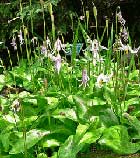 Erythronium species. DOG’S TOOTH VIOLETS are dainty woodland bulbs. They row about 1ft tall and flower in early spring, disappearing completely by early summer. Grow them in light shade, and also consider growing them under trees in the orchard or on a lawn. Suitable varieties increase very freely when well sited and the bulb, which can be 3 inches long and about an inch wide, has a pleasant sweet taste. It can be eaten raw or cooked. Any of the species can be used, though these are quite expensive to obtain and many people would consider the plant too beautiful to eat. The cultivars White Beauty and Pagoda are easily grown forms that are relatively cheap to buy and usually divide freely in the garden.
Erythronium species. DOG’S TOOTH VIOLETS are dainty woodland bulbs. They row about 1ft tall and flower in early spring, disappearing completely by early summer. Grow them in light shade, and also consider growing them under trees in the orchard or on a lawn. Suitable varieties increase very freely when well sited and the bulb, which can be 3 inches long and about an inch wide, has a pleasant sweet taste. It can be eaten raw or cooked. Any of the species can be used, though these are quite expensive to obtain and many people would consider the plant too beautiful to eat. The cultivars White Beauty and Pagoda are easily grown forms that are relatively cheap to buy and usually divide freely in the garden.
 Helianthus tuberosus. JERUSALEM ARTICHOKE is a fairly well known root crop that is sometimes seen in greengrocers. The plants are very vigorous, growing up to 10ft tall, and some people have been growing them successfully as part of a woodland garden, planting them on the sunnier side of the woodland. Slugs absolutely adore the young shoots in spring, so give the plants some protection at this time of the year - a mulch of oak leafmould works well. The main drawback of this root is that over half of the carbohydrate it contains is in the form of inulin and the body cannot absorb this. It does mean that you can eat quite a lot of it without putting on weight, but it does also mean that many people will find the inulin fermenting in their gut causes quite a bit of wind! The tubers can be eaten raw or cooked and the flavour improves if they are left in the ground until frosted.
Helianthus tuberosus. JERUSALEM ARTICHOKE is a fairly well known root crop that is sometimes seen in greengrocers. The plants are very vigorous, growing up to 10ft tall, and some people have been growing them successfully as part of a woodland garden, planting them on the sunnier side of the woodland. Slugs absolutely adore the young shoots in spring, so give the plants some protection at this time of the year - a mulch of oak leafmould works well. The main drawback of this root is that over half of the carbohydrate it contains is in the form of inulin and the body cannot absorb this. It does mean that you can eat quite a lot of it without putting on weight, but it does also mean that many people will find the inulin fermenting in their gut causes quite a bit of wind! The tubers can be eaten raw or cooked and the flavour improves if they are left in the ground until frosted.
.jpg) Lathyrus tuberosus. The TUBEROUS PEA has one of the most pleasant tubers to eat. Unfortunately the plant is rather low yielding and so unless improved cultivars are developed it will never become more than an occasional delicacy. Grow the plant on the sunny side of woodland, or perhaps in a cultivated bed amongst shrubs. It grows about 3ft tall and twines around available supports. It is quite a weak climber, however, and is more likely to sprawl across the ground. A member of the pea and bean family, the plant will enrich the soil with nitrogen.
Lathyrus tuberosus. The TUBEROUS PEA has one of the most pleasant tubers to eat. Unfortunately the plant is rather low yielding and so unless improved cultivars are developed it will never become more than an occasional delicacy. Grow the plant on the sunny side of woodland, or perhaps in a cultivated bed amongst shrubs. It grows about 3ft tall and twines around available supports. It is quite a weak climber, however, and is more likely to sprawl across the ground. A member of the pea and bean family, the plant will enrich the soil with nitrogen.
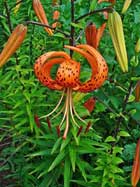 Lilium lancifolium. The TIGER LILY is often grown in the flower garden but in the Orient it is cultivated for its edible bulb. In fact when grown as a root crop the Chinese actually pick off the flower buds to stimulate the production of larger bulbs. All other members of this genus also produce edible bulbs, though these can often have a bitter flavour. When baked, lily bulbs taste rather like potatoes. One word of warning with this particular species - although tolerant of virus disease, it can often act as a carrier of these diseases and so becomes a vector infecting other species. It is therefore wise to either grow this species well away from your other lilies, or to avoid growing the other species if you grow this one. The plant is easily propagated by means of bulbils that form in the leaf axils. Simply pot these up in the summer when they part easily from the plant and then plant them out in the spring 18 months later. Allow some of the bulbils to fall to the ground to see if the plant will maintain itself without your help.
Lilium lancifolium. The TIGER LILY is often grown in the flower garden but in the Orient it is cultivated for its edible bulb. In fact when grown as a root crop the Chinese actually pick off the flower buds to stimulate the production of larger bulbs. All other members of this genus also produce edible bulbs, though these can often have a bitter flavour. When baked, lily bulbs taste rather like potatoes. One word of warning with this particular species - although tolerant of virus disease, it can often act as a carrier of these diseases and so becomes a vector infecting other species. It is therefore wise to either grow this species well away from your other lilies, or to avoid growing the other species if you grow this one. The plant is easily propagated by means of bulbils that form in the leaf axils. Simply pot these up in the summer when they part easily from the plant and then plant them out in the spring 18 months later. Allow some of the bulbils to fall to the ground to see if the plant will maintain itself without your help.
 Lomatium cous. Lomatium cous comes from western N. America and grows on dry often open rocky slopes and flats. It is often found with sagebrush, is most common in foothills and lowland areas but is occasionally found above the tree line. The root is eaten cooked; it can also be dried and ground into a flour and can then be mixed with cereal flours or added to soups etc. When dug up in the spring, it is said to have a parsnip-like flavour. Other members of this genus, in particular L. geyeri and L. macrocarpum may also be of interest. Known as BISCUIT ROOTS, they have celery-flavoured roots that can be eaten raw or cooked. The N. American Indians dried and ground them into flour and then either mixed it with cereal flours or added it to soups etc. They also mixed the flour with water, flattened it into cakes then sun-dried or baked them for use on journeys, the taste is said to be somewhat like stale biscuits.
Lomatium cous. Lomatium cous comes from western N. America and grows on dry often open rocky slopes and flats. It is often found with sagebrush, is most common in foothills and lowland areas but is occasionally found above the tree line. The root is eaten cooked; it can also be dried and ground into a flour and can then be mixed with cereal flours or added to soups etc. When dug up in the spring, it is said to have a parsnip-like flavour. Other members of this genus, in particular L. geyeri and L. macrocarpum may also be of interest. Known as BISCUIT ROOTS, they have celery-flavoured roots that can be eaten raw or cooked. The N. American Indians dried and ground them into flour and then either mixed it with cereal flours or added it to soups etc. They also mixed the flour with water, flattened it into cakes then sun-dried or baked them for use on journeys, the taste is said to be somewhat like stale biscuits.
 Orogenia linearifolia. INDIAN POTATO grows to about 15cm tall on open mountain sides and ridges, often in sandy or gravelly soils, and especially near vernal snowbanks where it blooms as soon as the snow melts. It is found in much of western N. America. The root is said to have a pleasant crisp taste, though the outer skin has a slightly bitter taste. Available at almost any time of the year, its only drawback is that it is a bit small and fiddly to harvest in quantity.
Orogenia linearifolia. INDIAN POTATO grows to about 15cm tall on open mountain sides and ridges, often in sandy or gravelly soils, and especially near vernal snowbanks where it blooms as soon as the snow melts. It is found in much of western N. America. The root is said to have a pleasant crisp taste, though the outer skin has a slightly bitter taste. Available at almost any time of the year, its only drawback is that it is a bit small and fiddly to harvest in quantity.

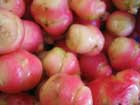 Oxalis tuberosa. OCA has had a long history of cultivation in S. America where it is one of the three most popular root crops. The tuber can be 3 inches long and about an inch wide - yields per plant are often not much below that from potatoes. The plants are about as hardy as potatoes, tolerating light frosts but dying down in harder frosts. In mild areas the tubers can be left in the ground and harvested as required (so long as the ground does not get too wet in the winter), but in colder areas it is best to harvest them when the plant dies down and store them in a cool frost-free place. The tubers have a lemon flavour when first harvested but if you leave them out in the sun for a week or so they become quite sweet. Some cultivars, in fact, become so sweet that they are eaten rather like a fruit in S. America. The main disadvantage of this plant is that it does not start to form tubers until around the autumn equinox and so, if there is an early heavy frost, yields will be very low.
Oxalis tuberosa. OCA has had a long history of cultivation in S. America where it is one of the three most popular root crops. The tuber can be 3 inches long and about an inch wide - yields per plant are often not much below that from potatoes. The plants are about as hardy as potatoes, tolerating light frosts but dying down in harder frosts. In mild areas the tubers can be left in the ground and harvested as required (so long as the ground does not get too wet in the winter), but in colder areas it is best to harvest them when the plant dies down and store them in a cool frost-free place. The tubers have a lemon flavour when first harvested but if you leave them out in the sun for a week or so they become quite sweet. Some cultivars, in fact, become so sweet that they are eaten rather like a fruit in S. America. The main disadvantage of this plant is that it does not start to form tubers until around the autumn equinox and so, if there is an early heavy frost, yields will be very low.
 Perideridia gairdneri. YAMPA root can be eaten raw or cooked and is said to have a pleasant sweet and nutty taste that can be eaten in quantity. The flavour is said to be somewhat like a superior parsnip and the dried root is said to be so nice that it is an almost irresistible nibble. The root is best harvested when the plant is dormant and can also be dried for later use or ground into a flour and used in porridges, cakes etc. Yampa grows in woodland and wet meadows in its native range, which stretches from California along the west of N. America to Saskatchewan in Canada, and so it should be perfectly hardy in Britain.
Perideridia gairdneri. YAMPA root can be eaten raw or cooked and is said to have a pleasant sweet and nutty taste that can be eaten in quantity. The flavour is said to be somewhat like a superior parsnip and the dried root is said to be so nice that it is an almost irresistible nibble. The root is best harvested when the plant is dormant and can also be dried for later use or ground into a flour and used in porridges, cakes etc. Yampa grows in woodland and wet meadows in its native range, which stretches from California along the west of N. America to Saskatchewan in Canada, and so it should be perfectly hardy in Britain.
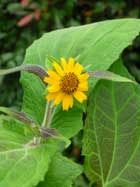
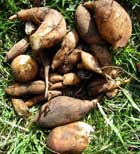 Polymnia edulis. YACON is often cultivated for its edible root in S. America, where yields of 15 tons per acre have been achieved. This frost-tender plant grows about 3ft tall and can be cultivated like potatoes. It requires a 6 -7 month growing season so would probably not succeed in the colder parts of temperate regions. It is best started off in pots even in the warmer areas. A fast-growing and tolerant plant, it succeeds in poor soils though it yields better in soils of at least reasonable quality and requires a sunny position. The large root is crisp and juicy and in some cultivars is also incredibly sweet, though the skin is often bitter. In S. America it is eaten more like a fruit than a root. The nutritional value is low, however, because much of the carbohydrate in the root is in the form of inulin. The human gut is unable to assimilate inulin and so it passes straight through the digestive system. This makes it an ideal food if you are on a diet to lose weight and want to eat enough to fill yourself up! A gentle warning, however, inulin causes fermentation in the gut of some people, leading to unpleasant wind. Inulin can be easily converted to fructose, a sugar that is safe for diabetics to use, and so it is sometimes used to make a sweetener.
Polymnia edulis. YACON is often cultivated for its edible root in S. America, where yields of 15 tons per acre have been achieved. This frost-tender plant grows about 3ft tall and can be cultivated like potatoes. It requires a 6 -7 month growing season so would probably not succeed in the colder parts of temperate regions. It is best started off in pots even in the warmer areas. A fast-growing and tolerant plant, it succeeds in poor soils though it yields better in soils of at least reasonable quality and requires a sunny position. The large root is crisp and juicy and in some cultivars is also incredibly sweet, though the skin is often bitter. In S. America it is eaten more like a fruit than a root. The nutritional value is low, however, because much of the carbohydrate in the root is in the form of inulin. The human gut is unable to assimilate inulin and so it passes straight through the digestive system. This makes it an ideal food if you are on a diet to lose weight and want to eat enough to fill yourself up! A gentle warning, however, inulin causes fermentation in the gut of some people, leading to unpleasant wind. Inulin can be easily converted to fructose, a sugar that is safe for diabetics to use, and so it is sometimes used to make a sweetener.
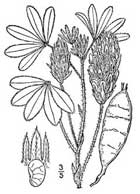 Psoralea esculenta. BREADROOT is a well known N. American Indian food. Perfectly hardy in this country, it requires a sunny position and like many members of the pea and bean family it helps to enrich the soil with nitrogen. The root can be eaten raw, cooked or be dried for later use. The dried root can also be ground into a flour and used in cakes, porridges etc. Starchy and glutinous, the raw root is said to have a sweetish turnip-like taste. The plant has in the past been recommended for commercial cultivation and has the potential to be high yielding.
Psoralea esculenta. BREADROOT is a well known N. American Indian food. Perfectly hardy in this country, it requires a sunny position and like many members of the pea and bean family it helps to enrich the soil with nitrogen. The root can be eaten raw, cooked or be dried for later use. The dried root can also be ground into a flour and used in cakes, porridges etc. Starchy and glutinous, the raw root is said to have a sweetish turnip-like taste. The plant has in the past been recommended for commercial cultivation and has the potential to be high yielding.
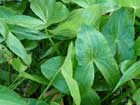 Sagittaria species. Most if not all members of this genus produce edible tubers and a number aare cultivated for this, especially in the Orient. They succeed in wet soils but are best in water 1 - 2ft deep. S. sagittifolia, the ARROWHEAD, is a native species and this is the plant that is most frequently cultivated. Its tubers can often be purchased in Chinese shops in this country and this is one of the best ways of obtaining plants, though the tubers need to be fresh if they are to grow away before rotting. The tubers are starchy with a distinct flavour that some people have likened to potatoes. There is a slight bitterness, but this is mainly in the skin that is best removed after cooking. They make a very acceptable stodgy part of the meal. The tubers can also be dried and ground into flour, this flour can then be used as a gruel etc. or can be added to cereal flours and used in making bread, biscuits or cakes. The tubers, which can be produced up to 1 metre from the plant, are best harvested in the late summer as the leaves die down. They should not be eaten raw. Other species to try include: - S. cuneata, the WAPATO, S. graminea; and S. latifolia, the DUCK POTATO.
Sagittaria species. Most if not all members of this genus produce edible tubers and a number aare cultivated for this, especially in the Orient. They succeed in wet soils but are best in water 1 - 2ft deep. S. sagittifolia, the ARROWHEAD, is a native species and this is the plant that is most frequently cultivated. Its tubers can often be purchased in Chinese shops in this country and this is one of the best ways of obtaining plants, though the tubers need to be fresh if they are to grow away before rotting. The tubers are starchy with a distinct flavour that some people have likened to potatoes. There is a slight bitterness, but this is mainly in the skin that is best removed after cooking. They make a very acceptable stodgy part of the meal. The tubers can also be dried and ground into flour, this flour can then be used as a gruel etc. or can be added to cereal flours and used in making bread, biscuits or cakes. The tubers, which can be produced up to 1 metre from the plant, are best harvested in the late summer as the leaves die down. They should not be eaten raw. Other species to try include: - S. cuneata, the WAPATO, S. graminea; and S. latifolia, the DUCK POTATO.
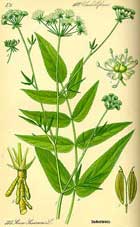 Sium sisarum. SKIRRET grows about 4ft tall and used to be cultivated for its edible root. This can be eaten raw or cooked and is firm, sweet and floury but with a woody core. The plant is very pest and disease-resistant. It requires plenty of moisture in the growing season otherwise its root will tend to be very fibrous. Make sure that you do not grow the sub-species S. sisarum lancifolium since this is very unlikely to produce good quality roots.
Sium sisarum. SKIRRET grows about 4ft tall and used to be cultivated for its edible root. This can be eaten raw or cooked and is firm, sweet and floury but with a woody core. The plant is very pest and disease-resistant. It requires plenty of moisture in the growing season otherwise its root will tend to be very fibrous. Make sure that you do not grow the sub-species S. sisarum lancifolium since this is very unlikely to produce good quality roots.
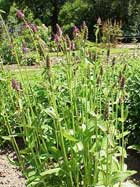
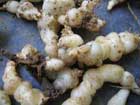 Stachys affinis. CHINESE ARTICHOKES grow about 1ft tall and dislike dry soils or shade. Their roots are rather small and fiddly, though overall yields are quite good and they have a pleasant flavour with a nice crisp juicy texture. They can be cooked or eaten raw, perhaps chopped up and added to a mixed salad. (Incidentally, there is an easy way of cleaning small and fiddly roots. You half fill a bucket with water, add a good quantity of dirt so that you have a nice muddy mixture. You then add all the roots that you want to wash and stir the mixture for a few minutes. Then tip out the roots and rinse them - they will be lovely and clean, ready for use.)
Stachys affinis. CHINESE ARTICHOKES grow about 1ft tall and dislike dry soils or shade. Their roots are rather small and fiddly, though overall yields are quite good and they have a pleasant flavour with a nice crisp juicy texture. They can be cooked or eaten raw, perhaps chopped up and added to a mixed salad. (Incidentally, there is an easy way of cleaning small and fiddly roots. You half fill a bucket with water, add a good quantity of dirt so that you have a nice muddy mixture. You then add all the roots that you want to wash and stir the mixture for a few minutes. Then tip out the roots and rinse them - they will be lovely and clean, ready for use.)
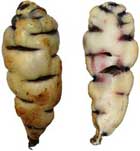
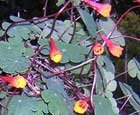 Tropaeolum tuberosum. This beautiful climbing plant is only hardy in the milder areas of temperate regions, where it can reach a height of 6 ft or more. It flowers freely in late summer and then dies down with the first hard frosts in the autumn. It produces a number of edible tubers near the soil surface and can be quite heavy yielding. In mild winter areas the tubers can be left in the ground (though it would be a good idea to mulch them), in colder areas they should be harvested and stored in much the same way as dahlias. The tubers are quite popular in S. America, but they are probably best described as an acquired taste. The rather peppery flavour is improved considerably if the tubers are cooked and then frozen before eating them. (You can warm them up again if you like!) Ken Fern found that if the tubers were left in the ground and then harvested after being frosted the flavour was better.
Tropaeolum tuberosum. This beautiful climbing plant is only hardy in the milder areas of temperate regions, where it can reach a height of 6 ft or more. It flowers freely in late summer and then dies down with the first hard frosts in the autumn. It produces a number of edible tubers near the soil surface and can be quite heavy yielding. In mild winter areas the tubers can be left in the ground (though it would be a good idea to mulch them), in colder areas they should be harvested and stored in much the same way as dahlias. The tubers are quite popular in S. America, but they are probably best described as an acquired taste. The rather peppery flavour is improved considerably if the tubers are cooked and then frozen before eating them. (You can warm them up again if you like!) Ken Fern found that if the tubers were left in the ground and then harvested after being frosted the flavour was better.
The tuber is considered by people in the Andes to lower the sex-drive and many men refuse to eat it, whilst recommending it for women! Clinical trials have indicated a reduction of up to 45% in some male hormones when the tuber forms a considerable part of the diet, but no loss in fertility has been observed. The growing plant is very resistant to diseases and insects; it contains nematocidal, bactericidal and insecticidal compounds. The main problem with growing this plant in temperate regions is that the tubers are not formed until the shorter days of autumn and if you get an early frost then yields can be very low. The cultivar Ken Aslett is probably the best form available in Britian; it comes into flower earlier and produces larger tubers than the species type.
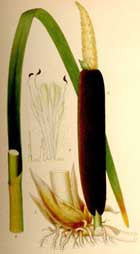 Typha latifolia. The British native REEDMACE is potentially one of the most productive rootcrops that can be grown. Not only that, its native habitat is marshy ground and shallow water where it makes a superb wildlife habitat. Reedmace might therefore be a productive crop in areas prone to flooding which would otherwise be difficult and expensive to protect.
Typha latifolia. The British native REEDMACE is potentially one of the most productive rootcrops that can be grown. Not only that, its native habitat is marshy ground and shallow water where it makes a superb wildlife habitat. Reedmace might therefore be a productive crop in areas prone to flooding which would otherwise be difficult and expensive to protect.
The root can be eaten raw or cooked. It can be boiled and eaten like potatoes or macerated and boiled to yield sweet syrup. The root can also be dried, ground into flour and then used as a thickener in soups etc or added to cereal flours. Rich in protein, this flour is used to make biscuits etc. Yields of 3 tonnes of flour per acre are possible, which compares very favourably with wheat. The plant also has many other edible and non-edible uses that we will not enumerate here. T. angustifolia is a closely related British native plant with the same uses.
Database
The database has more details on these plants: Apios americana, Camassia quamash, Cyperus esculentus, Dioscorea batatas, Helianthus tuberosus, Lathyrus tuberosus, Lilium lancifolium, Lomatium cous, Orogenia linearifolia, Oxalis tuberosa, Perideridia gairdneri, Polymnia edulis, Psoralea esculenta, Sagittaria cuneata, Sagittaria graminea, Sagittaria latifolia, Sagittaria sagittifolia, Sium sisarum, Stachys affinis, Tropaeolum tuberosum, Typha angustifolia, Typha latifolia.